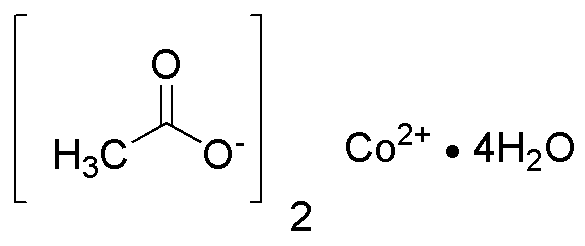Cobalt(II) acetate tetrahydrate is widely utilized in research focused on:
- Catalysis: This compound serves as an effective catalyst in various chemical reactions, particularly in organic synthesis, enhancing reaction rates and yields.
- Electrochemistry: It is used in electrochemical applications, such as in the development of batteries and supercapacitors, due to its ability to facilitate electron transfer.
- Textile Industry: Cobalt(II) acetate tetrahydrate acts as a dyeing agent, providing vibrant colors to fabrics while improving color fastness compared to other dyes.
- Material Science: The compound is employed in the production of cobalt-based materials, which are essential for manufacturing high-performance magnets and catalysts.
- Biochemistry: In biological research, it is used as a source of cobalt ions, which are crucial for studying enzyme activity and metabolic processes in living organisms.
General Information
Properties
Safety and Regulations
Applications
Cobalt(II) acetate tetrahydrate is widely utilized in research focused on:
- Catalysis: This compound serves as an effective catalyst in various chemical reactions, particularly in organic synthesis, enhancing reaction rates and yields.
- Electrochemistry: It is used in electrochemical applications, such as in the development of batteries and supercapacitors, due to its ability to facilitate electron transfer.
- Textile Industry: Cobalt(II) acetate tetrahydrate acts as a dyeing agent, providing vibrant colors to fabrics while improving color fastness compared to other dyes.
- Material Science: The compound is employed in the production of cobalt-based materials, which are essential for manufacturing high-performance magnets and catalysts.
- Biochemistry: In biological research, it is used as a source of cobalt ions, which are crucial for studying enzyme activity and metabolic processes in living organisms.
Documents
Safety Data Sheets (SDS)
The SDS provides comprehensive safety information on handling, storage, and disposal of the product.
Product Specification (PS)
The PS provides a comprehensive breakdown of the product’s properties, including chemical composition, physical state, purity, and storage requirements. It also details acceptable quality ranges and the product's intended applications.
Certificates of Analysis (COA)
Search for Certificates of Analysis (COA) by entering the products Lot Number. Lot and Batch Numbers can be found on a product’s label following the words ‘Lot’ or ‘Batch’.
*Catalog Number
*Lot Number
Certificates Of Origin (COO)
This COO confirms the country where the product was manufactured, and also details the materials and components used in it and whether it is derived from natural, synthetic, or other specific sources. This certificate may be required for customs, trade, and regulatory compliance.
*Catalog Number
*Lot Number
Safety Data Sheets (SDS)
The SDS provides comprehensive safety information on handling, storage, and disposal of the product.
DownloadProduct Specification (PS)
The PS provides a comprehensive breakdown of the product’s properties, including chemical composition, physical state, purity, and storage requirements. It also details acceptable quality ranges and the product's intended applications.
DownloadCertificates of Analysis (COA)
Search for Certificates of Analysis (COA) by entering the products Lot Number. Lot and Batch Numbers can be found on a product’s label following the words ‘Lot’ or ‘Batch’.
*Catalog Number
*Lot Number
Certificates Of Origin (COO)
This COO confirms the country where the product was manufactured, and also details the materials and components used in it and whether it is derived from natural, synthetic, or other specific sources. This certificate may be required for customs, trade, and regulatory compliance.

